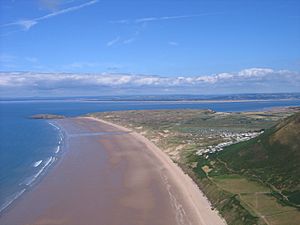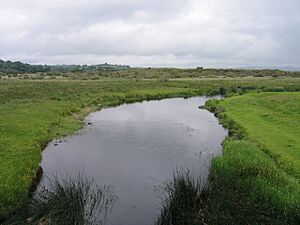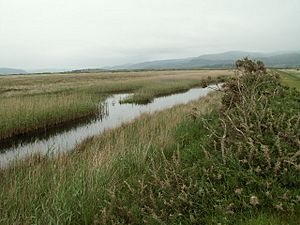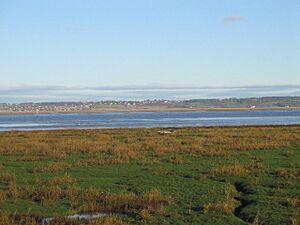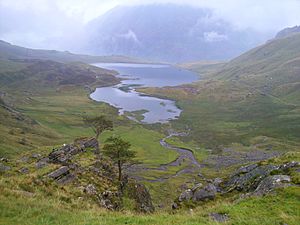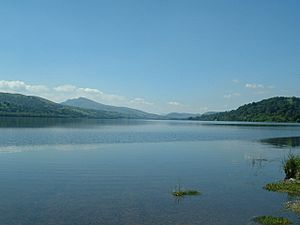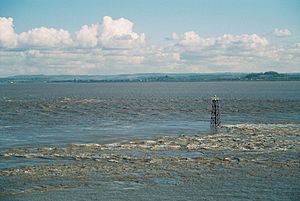List of Ramsar sites in Wales facts for kids
Wales is home to some incredibly special places called Ramsar sites. These are wetlands – areas like marshes, bogs, or lakes where water covers the land, or is very close to the surface. These wetlands are considered important for nature and wildlife around the world under something called the Ramsar Convention.
Wales currently has 10 of these amazing sites. Together, they cover a huge area of about 520 square kilometres (52,036 hectares)! If you want to learn about Ramsar sites in other countries, you can check out the worldwide list.
Contents
What are Ramsar Sites?
The Ramsar Convention is an international agreement that helps protect wetlands. It was signed in 1971 in a city called Ramsar in Iran. Countries that sign up agree to identify and protect their most important wetlands. These sites are chosen because they are vital for different kinds of plants and animals, especially birds, or because they are unique types of wetlands. Protecting these areas helps keep our planet healthy and full of diverse wildlife.
Special Wetlands in Wales
Here are the 10 important Ramsar sites you can find in Wales:
Burry Inlet
The Burry Inlet is located in Carmarthenshire. It covers about 66.72 square kilometres. This site was named a Ramsar wetland on 14 July 1992. It's famous for having the largest continuous area of saltmarsh in Wales. Saltmarshes are coastal wetlands that are flooded by tides. They are important nurseries for fish and homes for many birds.
Cors Caron
Found in Ceredigion, Cors Caron is a special type of wetland called a raised bog. It covers 8.74 square kilometres and became a Ramsar site on 28 September 1992. This bog is a fantastic home for animals like the European otter. It also provides a safe place for many wild birds and the endangered red kite, a beautiful bird of prey.
Cors Fochno and Dyfi Estuary
Also in Ceredigion, this site includes Cors Fochno and the Dyfi Estuary. It's quite large, at 25.08 square kilometres, and was one of the first sites designated in Wales on 5 January 1976. Cors Fochno is another raised peat bog. The Dyfi is an estuary, which is where a river meets the sea. It has salt marshes, sandbanks, mudflats, and a big area of sand dunes. These different habitats make it a great place for many different species.
Corsydd Môn a Llyn (Anglesey & Llyn Fens)
This site, known as Corsydd Môn a Llyn, includes fens on Anglesey and the Llyn Peninsula. It covers 6.26 square kilometres and was designated on 2 February 1998. Fens are wetlands fed by groundwater, which makes them rich in nutrients and home to unique plants.
Crymlyn Bog
Located in Swansea, Crymlyn Bog is a smaller site at 2.68 square kilometres, designated on 8 June 1993. Despite its size, it's a very important safe haven for many birds. These include the great bittern, water rail, sedge warbler, reed warbler, bearded tit, and grey heron. It's a busy place for birdwatching!
The Dee Estuary
The Dee Estuary stretches across Flintshire in Wales and the Wirral Peninsula in England. It's the largest Ramsar site in Wales, covering 143.02 square kilometres, and was designated on 17 July 1985. This estuary is important for its natural fisheries, including salmon and trout, as well as other sea and shell-fisheries. It's also a crucial feeding ground for many wading birds.
Llyn Idwal
Llyn Idwal is a small lake in Gwynedd, covering only 0.14 square kilometres. It became a Ramsar site on 7 November 1991. This beautiful lake is found within Cwm Idwal, a valley in the Glyderau mountains of Snowdonia. The area is known for its unique geology and plants that have adapted to the harsh mountain environment.
Llyn Tegid
Also in Gwynedd, Llyn Tegid is the largest natural body of water in Wales. It covers 4.82 square kilometres and was designated on 7 November 1991. This lake is home to a very special fish called the gwyniad, which is found nowhere else in the world and is now critically endangered. It also has a very rare type of snail called Myxas glutinosa.
Midland Meres and Mosses (Phase 2)
This site, known as Midland Meres and Mosses (Phase 2), covers 15.88 square kilometres and was designated on 2 February 1997. "Meres" are shallow lakes, and "mosses" are bogs. This area is important for its mix of different wetland types and the wildlife they support.
Severn Estuary
The Severn Estuary is a very large estuary that flows into the Bristol Channel. The Welsh part of this Ramsar site is in Gloucestershire and covers 247.01 square kilometres. It was designated on 5 January 1976. This estuary has important wildlife habitats that are exposed at low tide, including mudflats, sandflats, rocky platforms, and small islands. It's a vital place for migrating birds.
See also
- Ramsar Convention
- List of Ramsar sites worldwide


